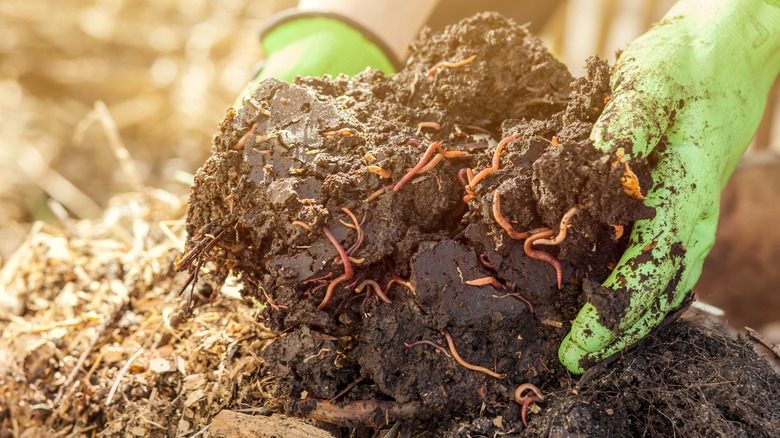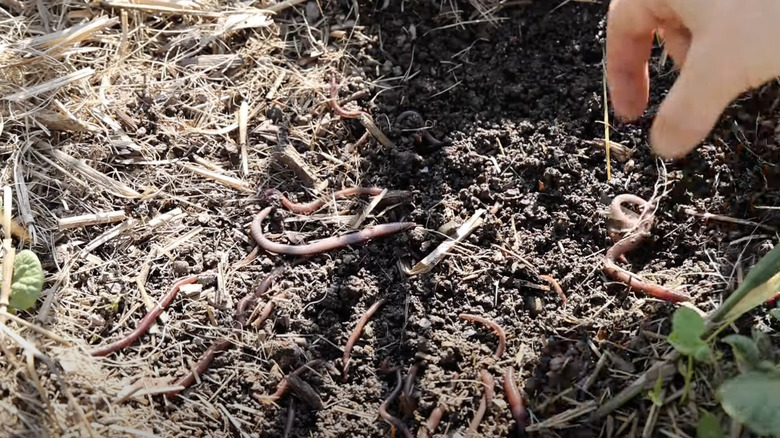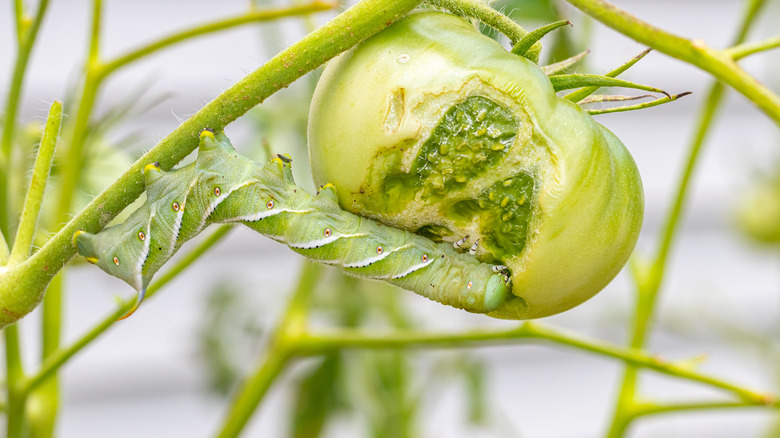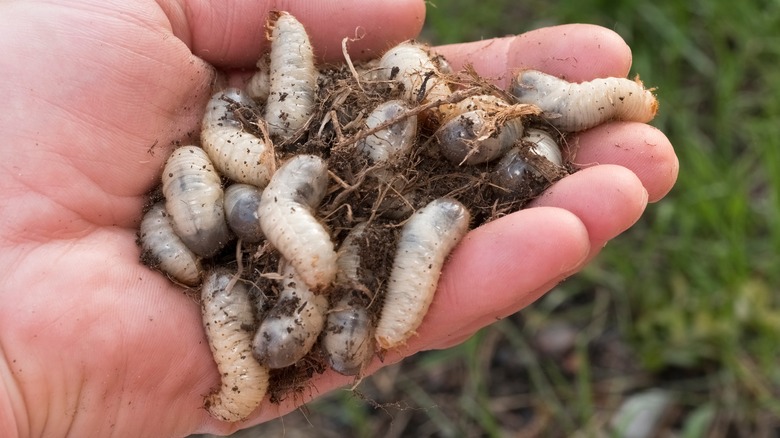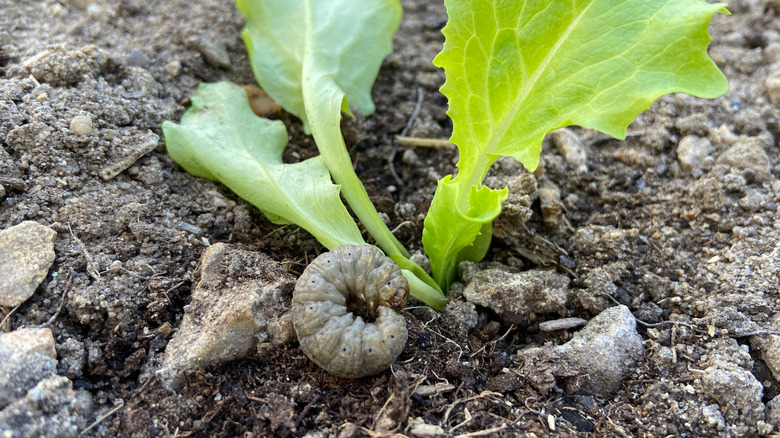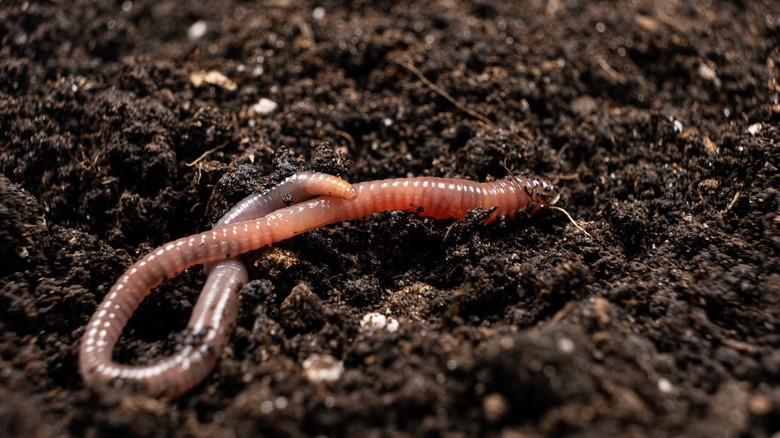Types Of Worms You Never Want To See In Your Garden
Having a successful garden is a balancing act that takes a lot of time and care, whether you are focusing on keeping stinkbugs off your vegetables or deciding which weeds you should or shouldn't pull. However, one thing you may not have put much thought into before is worms. This is because most of us have been told all of our lives that seeing worms in the garden is a good sign since these tiny creatures ingest organic matter and then turn it into food for beneficial microbes. The microbes then further break the organic matter down and make important nutrients bioavailable for plants. And what gardener wouldn't want their plants to have access to more nutrients?
Unfortunately, not all worms are good news. In fact, some types of worms are ones that you will never want to see in your garden, whether that's because they munch on your vegetables or are invasive species that outcompete other worms. So, here's a list of the slimy garden villains to look out for so that you can more easily decipher between good and bad worms and evict the bad ones from your vegetable patch.
The invasive Asian jumping worm
The first worm that you don't want to see in your garden is the Asian jumping worm (also known as the Alabama jumper, jumping worm, snake worm, and crazy worm). This worm gets its name because it tends to live in dead leaves above the dirt and wiggles and thrashes around when touched. These worms are bad news because they are invasive and out-compete other earthworms by eating more and breeding faster.
On top of out-competing other worms, the Asian jumping worm also robs the soil of important organic materials needed by other creatures. This causes native insects, microbes, and fungi not to have enough food to thrive or, in some cases, survive. It also disrupts the life cycle of native wildflowers and prevents their growth. Plus, after the jumping worms have eaten all the organic matter, they also don't leave the soil better off than they found it. In their wake, jumpers create poor soil that has the texture of used coffee grounds, doesn't hold water, and erodes more easily.
The best way to deal with these pests is to pick them from your soil, place them in a garbage bag, and then toss them in the trash.
Tomato-munching hornworms
Hornworms aren't technically worms but caterpillars that later develop into large hawk moths (sometimes called sphinx or hummingbird moths). These moths are beneficial native pollinators. However, despite being great as adults, you probably don't want to see hornworms in your garden because they have a hankering for tomatoes and will eat all the foliage — and sometimes even the unripe fruits — off of your plants. While hornworms are quite large (growing up to four inches), they can be surprisingly hard to see with their well-camouflaged bright green bodies.
Although they prefer tomatoes, these green terrors can also be found consuming other nightshades like peppers, potatoes, and eggplants. You may be able to tell that you have a hornworm problem in your garden if you see parts of plant leaves entirely eaten or missing and notice dark brown or green droppings on the plant. If you see this, you can start looking under leaves for hornworms.
Luckily, once you've found it, a hornworm is pretty easy to get rid of. Simply chop off the branch he's sitting on and relocate him to a nearby park. If you are feeling particularly vengeful, you can put him out in the open for a hungry bird. In fact, leaving a few pesky worms out is a good way to attract more bug-eating birds to your garden.
Root-destroying grub worms
Grub worms, like hornworms, are technically not worms but are rather the larvae stage of various species of scarab beetles, including Japanese beetles, June beetles, and masked chafers. While these little vigorous munchers are typically found eating the roots of grass in your lawn, they are also sometimes found in the garden where they tend to eat young plants, root vegetables, or ornamental flowers with shallow roots like chrysanthemums and begonias.
However, just seeing a few grub worms in your garden is not a cause for panic. In fact, according to Texas A&M (as reported by the Waco Tribune-Herald), you don't need to start worrying until you find around five or more grubs for every square foot of soil. Then, you will need to test the rest of your garden and lawn to see if you have an infestation.
Luckily, if you do have an infestation, simply picking the critters out of the garden and leaving them above ground and exposed to birds is a great way to start getting rid of them. Unlike hornworms — whose adult form is beneficial to the garden — certain species of grub worm grow up to become beetles that will also eat your plants. So, if you have an infestation, it's a good idea to start treating it early.
Stem-choking cutworms
Cutworms (like many others on this list) are technically caterpillars and not worms, but their shiny bodies and brown coloring can make them look more like worms to the untrained eye. Cutworm is a generic term for a large variety of caterpillar species that later become different types of brown moths. These critters, while smaller and more innocent-looking than hornworms and grub worms, can easily cause more damage because they wrap themselves around the stem of a plant and then chew through it. When a cutworm eats through the base of a plant, it often causes the entire plant to die, leaving you without a harvest. Cutworms like to attack young plants and enjoy eating a wide variety of flowers, fruits, and vegetables. They also tend to come out to feed at night, which means you may not even know they are there until it's too late.
A good way to prevent cutworms from becoming a problem in your garden is by tilling your soil in the spring to disrupt and kill any possible larvae. You can also be proactive about weeding and removing dead plants so that adult moths have no place to lay their eggs. If you already have cutworms, you can protect young plants by making a ring around the stem with cardboard or aluminum foil.
Even earthworms aren't so innocent
Interestingly enough, while many of us grew up hearing that earthworms are a very important part of the ecosystem, all earthworms in North America are non-native and invasive. Although we've pretty much accepted some species of European earthworms as part of the ecosystem in much of the U.S., in reality, native earthworms in North America all died during the last ice age. Since that time, many native North American plants and animals have evolved to live in a world without worms.
However, while earthworms aren't great for native wildflowers or forests, they seem to be pretty beneficial in the garden. So, if you see earthworms in your garden (as long as they aren't Asian jumping worms), feel free to let them be. However, to avoid further harming the native ecosystem, it is recommended not to purchase or add more worms to your yard. If you are afraid that you don't have enough worms in your garden, you can attract them by providing food — like dead leaves and grass clippings — and by keeping your soil moist.
